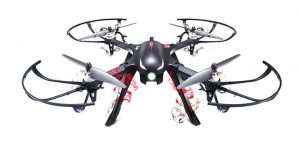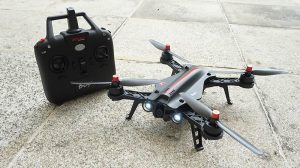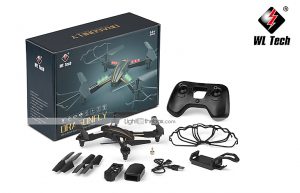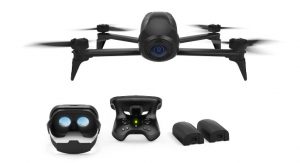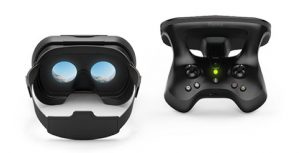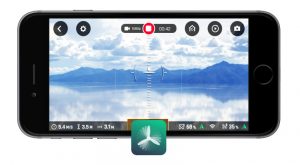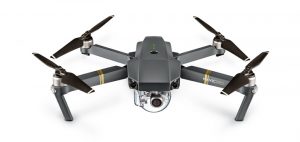DLFPV is a new brand specializing in FPV products and its latest drone — the Swift DL-1060 micro FPV racer with brushed motors is one of the most exciting things to hit the FPV scene recently.
Why exciting? Because it costs just $100 and is a complete micro 5.8G FPV racer that comes with its own transmitter (remote controller) and FPV monitor or headset. 5.8G micro FPV racers aren’t new and they’ve been around since last year but a micro that has everything you need for 5.8G FPV flying for just $100 is still something of a rarity.
In the past, getting into 5.8G micro FPV flying meant buying a micro FPV drone and then deciding which radio you want to use for your drone. The drone may or may not come with its own FPV monitor or headset and if it didn’t, you’d have to decide which monitor or headset to buy. These decisions may not seem too hard for seasoned pilots but for beginners who are just discovering micro FPV drones, it can be a bit intimidating and confusing, especially when it comes to choosing which radio to buy since there are a number of different brands out there and receiver/transmitter compatibility can sometimes be an issue.
Product Highlights
- Dimensions: 110 x 110 x 70mm (with camera mounted)
- Platform: Quadcopter
- Diagonal motor distance: 85mm
Flight features:
- Flight modes: Stability, Medium and High
- 3D flips
- Headless mode
- Propulsion: 14300kV 720 brushed motors / 23mm 3-blade propellers
- Weight: 47g (with battery and camera) / 35g (without battery / with camera)
- Supplied battery: 3.7V 430mAh 1S Li Po
- Charging time: about 30 minutes
- Flight time: about 5 minutes
- Control distance: about 50m to 100m
Camera resolution: 600TVL
- Camera FOV: 148 degrees (horizontal)
- FPV channels: 40
- FPV transmission power: 25mW
- FPV transmission range: 150 – 200m
The guys at DLFPV probably realized this and came up with the DL-1060 which was designed specifically for beginners. It’s a geat kit for anyone who’s just starting out in FPV and have yet to learn the ropes. The DL-1060 comes in four different kits:
- DL-1060 (transmitter with drone)
- DL-1060W (transmitter, drone, camera)
- DL-1060WG (transmitter, drone, camera, FPV headset)
- DL-1060WM (transmitter, drone, camera, FPV monitor)
The kit featured in this review is the DL-1060WM and was kindly sponsored by DLFPV.
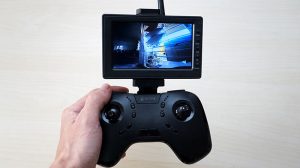
When I first got my hands on the DL-1060, I was impressed with the design and quality of its transmitter. Some toy drones in the $100 price range still come with ugly and uncomfortable transmitters but the DL-1060’s Tx looks very well designed. It may not feature rubberized coating but it feels very comfortable in the hands. For a drone that costs just $100, the DL-1060’s Tx has excellent ergonomics, comfort and looks.
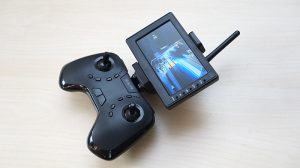
With the bundled transmitter, there is nothing you need to worry about regarding compatibility or specific binding procedures for your transmitter — something you’ll need to know if you’re messing around with FrSky or Spektrum systems, for example. Just turn on the drone and transmitter and move the throttle stick up and down to bind (connect) the Tx to the drone and you’re ready to fly. It is that easy. When flying the DL-1060, I feel the Tx is very comfortable and has just the right shape and size for my hands.
Flight Performance
The DL-1060 has 3 pre-set flight modes — Stability, Medium and High. Stability mode is the slowest of the three while High unleashes the full power of the drone’s propulsion. Of the three modes, Stability seems to be the most interesting one. This mode is on when you see the green LED light on the left LED array of the transmitter.
Although the DL-1060 doesn’t actually have a barometer for altitude hold (a feature for automatically maintaining flying altitude), throttle control on it seems to mimic altitude hold on toy drones that have the feature. When the throttle is pushed down to zero, the motors do not shut off completely and continue spinning, causing a slow descend. When the throttle is maxed out, you get a gradual ascend. Earlier when testing the DL-1060, I had suspected that it doesn’t have a barometer and this was later confirmed by DLFPV themselves.
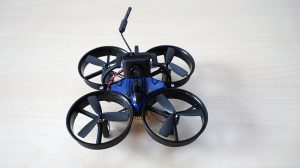
This subdued throttle control response is a great feature to have for beginners. Beginners generally have difficulty hovering their drones at a fixed altitude with manual throttle control. This why altitude hold was introduced into toy drones in the first place — to make them easier to hover. Hovering a drone with manual throttle is a skill that takes time to develop and less experienced pilots tend to over-correct or under-correct their throttle, resulting in an unstable flight which can result in crashes.
This simple throttle feature in Stability mode is brilliant and makes the DL-1060 easier and more fun to fly compared to other toy drones (even those that come with real altitude hold). This makes me wonder why such a feature that doesn’t require a barometer wasn’t introduced earlier. Toy drones with altitude hold can sometimes feel choppy or erratic when flying especially when it’s windy. This is not an issue with the DL-1060.
In Medium and High modes, you get manual throttle control and flight speeds are a lot faster. These two modes are more suited to experienced pilots. Yaw rate is also higher in Medium mode and highest in High mode. Automated 3D flips can be performed in Medium and High but not in Stability mode.
Overall, the DL-1060 is a lot of fun to fly indoors and its Stability mode makes it an excellent choice for beginner pilots. All flight features on it are pre-set and it does not come with a micro USB port that allows you to connect using a computer to configure its flight controller. Since the DL-1060 is aimed at beginners, I believe there is no need for such a feature.
Camera and FPV monitor
The DL-1060 features a 5.8G FPV camera with a built-in 25mW video transmitter. It sits suspended on top of the drone attached to a nylon mount that allows the camera to tilt up and down. The mount is simple yet functional and flexes quite a bit to absorb impact during hard landings or crashes. The camera can be detached form this mount without using any tools.
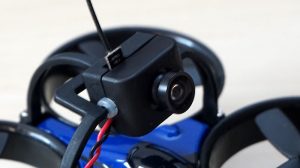
The camera features an omnidirectional antenna which works quite well. Although not as superior as cloverleaf antennas in terms of transmission performance, it is not as fragile and won’t easily get damaged during crashes compared to cloverleafs. It also features a 1/3 CMOS sensor and 40 FPV channels which can be switched by pressing the channel buttons with a pin.
Image quality is quite good and the CMOS sensor performs reasonably well even in low light conditions such as flying indoors relying only on artificial lighting at night. Though image noise levels are high in low lighting, you can still see enough details to fly properly. The camera also features a 150 degree field of view which is just about right for FPV flying.
The DL-1060WM kit comes with a 4.3″ FPV monitor (480 x 272p resolution) that can be attached to the top of the transmitter using a grip mount. Display quality is quite good and the monitor comes with an omnidirectional antenna that can be removed should you need to upgrade to a better antenna for improved reception. No sunshade is provided although the monitor does have slots at the top and sides for installing one.
The monitor can receive up to 40 FPV channels and channel search is done manually. It also comes with a built-in battery and a micro USB charging port. This means you can use common micro USB chargers for it.
Conclusion
Overall, I am very impressed with the DL-1060. At a glance, it may look like any other micro FPV racer but at just $100, it gives you the full 5.8G FPV experience without burning a hole in your wallet. Considering that many other toy drones without 5.8G FPV cost about $30 to $100, the DL-1060 offers plenty of value.
With its Stability mode that makes flying and hovering easy, this is one toy drone that was clearly designed for beginners. If you’re looking to discover 5.8G FPV flying but do not wish to spend big money on some fancy FPV headset, transmitter and brushless drone then the DL-1060 is an excellent choice.
The only reason why one would consider some other toy drone over the DL-1060 would probably be looks. This is one toy drone that doesn’t have anything fancy or sophisticated when it comes to looks. However, it more than makes up for that with its excellent flight performance, well-designed transmitter and decent 5.8G FPV system.
